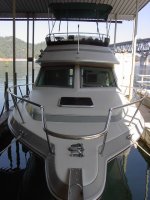Glad the problem is resolved and you can get back to the serious business of life: fishing!
I would suggest that when a boat is purchased (new or used) that you go thru the circuits, label all of the wires. I have a small labeler which we keep on each of the boats. We traced out all of the wires on the Tom Cat and the CD 25, added fuses, breakers where appropiate (by ABYC rules) and labeled each end of the line, plus tried to label all of the fuses.
The two windlasses I have on the C Dory boats have a direct "X" switch, rather than selenoids. (I have the Lewmar 700 and 700 FF (free fall), which are virtually identical, except for the mechanism which allows the clutch disengagement on the FF unit.
These smaller windlasses are low power draw. In most of my other boats, I have used selenoids--but in the smaller power draw, I belive that the direct switch has an advantage by its simplicity and avoiding putting selenoids in the area which is often wet (anchor rode locker).
Also, look very carefully at all of the crimps, insullation and if wires have been partailly cut or pinched. You may decide, as I did, that some of the wires are undersized, and run parallel circuits to the major bus bars.
It is farily easy to add a bail to the anchor pulpit--and in John's case, that will probably be advisable. Just a piece of 3/16" thick x 1/2" wide (approx) SS, bent in a "U" shape, and bolted or tack welded to the sides of the anchor pulpit will suffice. I agree that it is advisable to avoid the foredeck, especially at night in a seaway!


